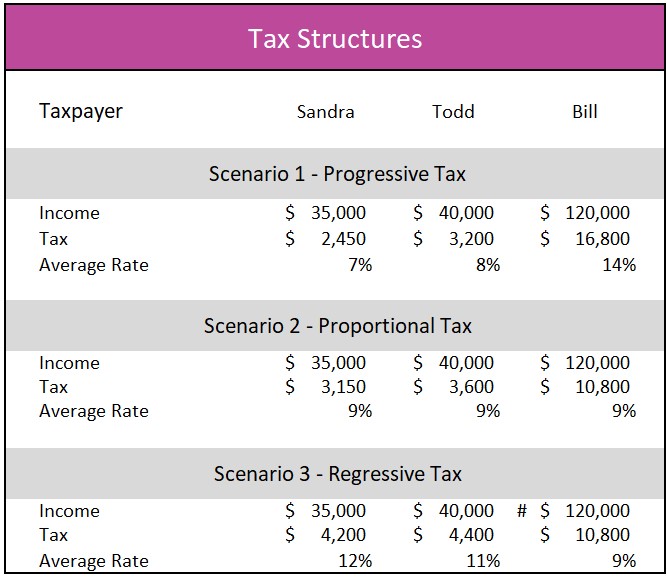When all income is taxed at the same rate, the tax is a proportional or "flat" tax.
In a truly proportional tax, every dollar earned from the first to the last dollar would be taxed at the same rate. For example, assume the tax rate is 25 percent. A family earning $100,000 would pay $25,000 in taxes, and a family earning $50,000 would pay $12,500. The oldest example of a proportional tax is the biblical concept of tithing. The Israelites were commanded by God to pay 10 percent of their income. The average and marginal tax rates are equal with a proportional tax because the next dollar earned is taxed at the same rate (marginal tax rate) as the first dollar earned. A payroll tax (Social Security and Medicare) is a flat tax because everyone pays 7.65 percent of their income - that is until they earn $127,200, after which the marginal rate falls to zero. Since no taxes are paid on income exceeding $127,200, payroll taxes are technically regressive. Several states had proportional income taxes in 2016. These include North Carolina, Massachusetts, Utah, and Indiana. (In some cases the percentage may not apply to all income, and the state may offer a few deductions and exemptions.)
Students need to distinguish between proportional, regressive, and progressive tax systems. A regressive tax is a tax where low-income taxpayers pay a larger portion of their income. The average tax rate decreases as the taxpayer’s income increases. The sales tax is a regressive tax. Assume the sales tax is five percent, and a basket of goods costs $100. Everyone purchasing the basket would pay a sales tax of $5. Other examples include user fees to renew a license, tolls, or entry into a park.
In a progressive tax system, a taxpayer’s average tax rate increases as the taxpayer’s income increases. Most developed countries have a progressive income tax. Policymakers contend that higher-income individuals should shoulder more of the responsibility of paying for the goods and services government provides. They are better able to afford it, and perhaps they have more to gain. Higher-income people are more likely to travel, and so they benefit more from roads. Wealthier citizens have more to lose from the destruction of war, so they should pay more for the military. Other examples of a progressive tax are the estate tax and the luxury tax. In the United States, an estate tax is not paid until the value of an estate exceeds $5.49 million. A luxury tax is frequently charged for luxury items that only the wealthy can afford.
The easiest way to distinguish between a progressive, regressive, and proportional (flat) tax is with an example. Sandra is a teacher. Her annual salary is $30,000. Todd works in the athletic department of a university and earns $35,000 per year, and Bill is a mortgage broker who earns $150,000 annually.

In Scenario 1 Sandra pays $2,000 in taxes, Todd pays $3,500, and Bill pays $40,000. This is a progressive tax system because Sandra pays the least amount of tax and has the lowest average tax rate (6.67%), while Bill pays the most tax and has the highest average tax rate (26.67%). In Scenario 2, the incomes remain unchanged, but the government changes the tax system so now Sandra pays $3,000 in taxes. Todd pays $3,500, and Bill pays $15,000. Scenario 2 illustrates a proportional tax system because the average tax rates of all the taxpayers equals 10 percent. In Scenario 3, income is once again unchanged, but the government changes its tax system so Sandra, Todd, and Bill are taxed $4,000, $3,500, and $12,000, respectively. Scenario 3 has a regressive tax system because Sandra, who has the lowest income has the highest average tax rate (13.33% vs Bill's rate of 8%).
Many publications list the sales tax as a proportional tax because the same rate is applied to all purchases. However, most economists consider the sales tax to be a regressive tax. Why? A regressive tax is based on the relationship between a tax owed relative to the taxpayer’s income. When the tax is determined by the value of an asset it is the same for whoever is purchasing the good or service – regardless of their income. For example, assume the sales tax is five percent, and a basket of goods costs $100. Everyone purchasing the basket would pay a sales tax of $5. $5 is a larger proportion of a poorer person's income than a person with a higher income, making the sales tax regressive.
In summary, assume a government needed tax revenues of $20 trillion. High-income payers would pay a larger portion of the $20 trillion with a progressive tax structure than a proportional tax structure or a regressive tax structure because the marginal tax rates increase as income increases. The lower-income taxpayers would shoulder a larger portion of the $20 trillion tax burden relative to their incomes in a regressive system. In the United States, the income tax is progressive, but most other taxes and user fees are regressive.
The Federal Budget and Managing The National Debt
Fiscal Policy – Managing an Economy by Taxing and Spending
Aggregate Supply and Demand – Macroeconomic Equilibrium